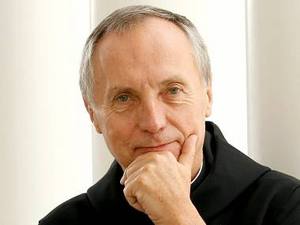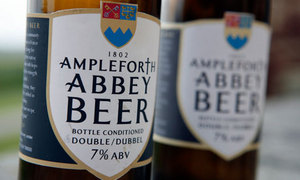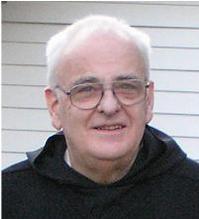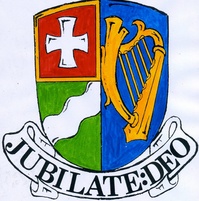Saint Joseph Seminary College located at Saint Joseph Abbey (Covington, LA) suffered a fire overnight. the fire apparently started in the computer server room. Everyone –64 students displaced– is reported well.
Category: Benedictines
Young Catholic monks maintain tradition, respond to needs in faith
 The Benedictine Abbots are going home now. They’ve
The Benedictine Abbots are going home now. They’ve
been meeting in Rome since the 17th. Their work was not deliberative
in any meaningful way as much as they gathered for the reason to elect an abbot primate, to gain perspective, to meet new and old monastic superiors, to hear how the worldwide Benedictines can assist one another in living the life more effectively and intensely according to the Holy Rule and the mind of the Church. Time was spent in prayer, study, and pilgrimage. How could one not spend time in prayer before the holy places of the martyrs in Rome as well as some of the central points of interest to Benedictines. Cindy Wooden from CNS published this
article today as a sort of synopsis of one aspect of Benedictine life–the
attraction of new members. Father Michael Casey, a Trappist monk, priest, author and speaker, addressed the assembly. He, by the way, is one of my favorite contemporary monastic thinkers. If only the abbots and other monastic superiors would listen to Father Michael. Alas, they’re too timid and many can’t (won’t?) do the hard work necessary to figure out what they ought to do so as to not live in diminishment mode. One often gets the feeling that some monasteries would rather die than alter their Benedictine observance and the adherence to Christ and the Church. But, I will say that despite a lack of clear and intense thinking, praying and living, there are significant points of like for Benedictine monasticism in the USA.
congress was Cistercian Father Michael Casey, an expert on monastic
spirituality from Tarrawarra Abbey in Australia.
responding to changing needs is an inescapable part of life, both for
individuals and for religious communities, he said. “The fact that we are
alive means that we are continually influenced by our past, continually
interacting with our present, and looking forward to the future. It’s really
just a matter of personal integrity, personal vitality that we do respect and
allow our past to continue speaking to us.”
Continue reading Young Catholic monks maintain tradition, respond to needs in faith
Pics of the St Meinrad Archabbey
 Here are some wonderful photos of the Archabbey of Saint Meinrad (in southern Indiana) by Mark S. Abeln, a photo journalist and blogger of 2010. The images are posted on Mr. Ablen’s blog, Rome of the West. I hope he has time to go back to and record some of the monk’s life, particularly the sacred Liturgy.
Here are some wonderful photos of the Archabbey of Saint Meinrad (in southern Indiana) by Mark S. Abeln, a photo journalist and blogger of 2010. The images are posted on Mr. Ablen’s blog, Rome of the West. I hope he has time to go back to and record some of the monk’s life, particularly the sacred Liturgy.
Notker Wolf re-elected Abbot Primate for world-wide Benedictines
 Abbot Notker Wolf, 72, was elected for the third time by the world’s abbots and conventual priors who are at the quadrennial meeting currently in session at Sant’Anselmo, Rome.
Abbot Notker Wolf, 72, was elected for the third time by the world’s abbots and conventual priors who are at the quadrennial meeting currently in session at Sant’Anselmo, Rome.
Abbot Dr. Notker was the Archabbot of St Ottilien when he was elected the Abbot Primate in 2000. Abbot Notker professed vows in 1962, ordained in 1968, elected abbot in 1977, and elected the primate in 2000, 2008, and now in 2012. Abbot Notker will serve in the Office of the Primate for 4 years.
The election for the Primate’s Office happened today 9am Rome time following the singing of the Office of Terce. Typically the election for Primate is chaired by the Archabbot of Montecassino, but being sick, instead of Abbot Pietro, the Abbot of Subiaco, Mauro Meaci chaired the election. Each monastic superior was called forth to drop his vote. Dom Mauro announced the tally, and called on Abbot Notker seeking to know if he accepted election. He did accept. According to law, the re-elected Abbot Primate made a profession of faith and the oath of fidelity with his hand on the Bible. All assembled then sang the Te Deum followed by a solemn blessing imparted by the Abbot Notker. Noon Mass was celebrated at the nearby Santa Sabina Church and the normal work of the Congress continued.
As an aside, the Prince of Jordan was with the monks for lunch on the 20th.
May God grant him the graces needed to fulfill his person and work.
But with all this very good work done by the Primate and his staff, there’s much work to do. Not all is complete and Abbot Notker can’t rest on his laurels. Several things, in my considered opinion need attention: getting name recognition of Sant’Anselmo better known, especially in the USA, the greater cultivation of benefactors, the attraction of new monks, nuns and laity to teach at the Anselmo, to develop more dynamic programing in the constituent academic areas, to attract talented people –not necessarily monks, perhaps the utilization of the Oblates– to work there. Plus, it is reasonable to say that he and his staff ought to use technology much better to communicate with the world’s monks and nuns but also with the laity. There are a great amount of Oblates who love the love the Benedictine way of life and would appreciate being included more for the effective advancement of what is proposed by the Rule and the Church. It is disappointing that the Confederation doesn’t use technology viz. the Primate’s office and the school. The Curial offices on the Aventine Hill don’t need to feed the media monster but they do need to communicate more effectively using the internet, especially in the renewed emphasis the Church has placed on the proclamation of the Word of God. For example, the OSB website, Wikipedia and Confederation websites need a serious overhaul. Perhaps doing more work with the interface of monasticism and evangelization would be good as well as forming an international group of Oblates to live, work and pray as a community for the good of the Confederation.
Abbot Wolf can’t do this work all alone and in a short amount of time. He is 72 with realistically a term to work as Primate (4 years is not a long time). Abbot Notker needs our sincere prayer, fraternal and financial support.
On the Confederation, etc.
“The Benedictine Confederation was formed those monastic Congregations which, while preserving their autonomy, entered the union sanctioned by Pope Leo XIII in a the Papal Brief “Summum semper” and regularly approved by all of his successors. By order of Pope Pius XII precise legal prescision was made for this union in a Lex propria which was reviewed after the Second Vatican Council (1),”
The Benedictine Confederation was constituted and continues to exist in order that led by the Gospels, under the guidance of the Holy Spirit and directed by the Church, monastic life according to the Rule of Saint Benedict and the wise traditions of each Congregation and monastery adapted to the conditions of time and place may be fostered and fraternal assistance between Congregations in the areas of personnel, goods and works be encouraged in every way” (16).
“The Congress is not intended to be a Chapter General nor does it possess any power at variance with the autonomy of the Congregations or of monasteries; rather it serves the good of the Confederation with the limits described above (nos. 16-17)” (20).
All Benedictine saints and blesseds, pray for Abbot Notker, the Benedictine curia, and for us.
Getting a handle on Benedictine life — Subiaco style
You might ask why I care about the Subiaco Congregation… well, I care about the Congregation because it’s the largest and most diverse of all the groupings of those who follow the Benedictine Rule, and many of the monasteries do interesting things outside the typical works of parochial and educational ministries. And, because I care. Subiaco monks and nuns tend to be more focused on living the monastic life with intensity. One may also say that the English Benedictines have certain intensity in life and ministry which distinguishes them from other groupings.
Subiaco Congregation of monks meet
 The General Congregation of the Subiaco Congregation of Benedictine monks are meeting this week at one of the monasteries founded by Saint Benedict, Saint Scholastica Monastery, Subiaco, Italy.
The General Congregation of the Subiaco Congregation of Benedictine monks are meeting this week at one of the monasteries founded by Saint Benedict, Saint Scholastica Monastery, Subiaco, Italy.
Be opened!
 The gospel for today has the word, “Be opened” –in other words, listen. It is a word that is most known by Christians in the Rite of Baptism where the priest touches the ears of the person to be christened saying, “Be opened.” Later in history, the word is made more famous for being the first word in the Rule of Benedict, Listen.
The gospel for today has the word, “Be opened” –in other words, listen. It is a word that is most known by Christians in the Rite of Baptism where the priest touches the ears of the person to be christened saying, “Be opened.” Later in history, the word is made more famous for being the first word in the Rule of Benedict, Listen.
A Swan Song
In view of the
swan episode that I experienced a few weeks ago St Louis Abbey with their swan walking the street, I thought you’d want to know
that Abelard the Abbey swan was found dead yesterday morning by the maintenance staff
of the Priory School (St Louis Abbey). My friend Father Ambrose wrote me about
this event. They think he was probably killed by coyotes or maybe by a big dog.
Whether you have a liking for birds, I am sorry about this. Abelard was a
beautiful animal. He was already 18 years old; in captivity, swans can live
into their twenties. So he was already old by swan standards; and I think his
mind was going. In fact, after I left, he wandered off several more times and
had to be brought back. I think he had the swan version of Alzheimer’s. Also,
several of the monks think he missed Father Michael (who used to take care of
him and give him bread scraps, etc.). So he was old and debilitated, and in the
natural order of things, another species brought about his demise.
Now the
Priory has all those odious Canada geese.
Abeland died on my friend’s priestly
ordination anniversary, the feast of St. Augustine. Abelard came to live with the
monks as a gift from Father Bernard, back in 1998.
You may want to see Father Augustine’s update on the Juniors at St Louis Abbey!!!
Benedictine abbots to meet in Rome
 The Office of the Abbot Primate announces…
The Office of the Abbot Primate announces…
Almost 300 monastics will gather in Rome, 17-25 September 2012, for the international Congress of Benedictine Abbots and Conventual Priors at the Primatial Abbey of St. Anselm on the Aventine Hill. Preceding the Congress, new monastic superiors will participate, 15-16 September 2012, in an orientation program. 25 representatives from Communio Internationalis Benedictinarum (CIB), an association of Benedictine sisters and nuns, will also attend the Congress. The Abbot Primate has invited ecumenical guests from the Orthodox and Reformed traditions.
Benedictine monasteries, and Fr. Michael Casey OCSO offering a paper on autonomy in Benedictine life. In addition, a wide range of workshops will address current topics in monastic life; such as, Benedictine identity, stress and burnout, associate membership programs, management of monasteries, individualism in the monastery, relationship with Benedictine women, new forms of Benedictine presence in society, ecumenism, the paschal mystery in the sacred liturgy, new directions for inter-monastic dialogue, new structures for AIM, the changing role of the Athenæum S. Anselmo,the sexual abuse crisis, the role of the abbot, communio in the confederation,and the formation of “traditionalist” candidates.
The assembled abbots and conventual priors will have the opportunity to visit in pilgrimage the monasteries of Subiaco, Montecassino, Norcia, and Camaldoli, which is celebrating its 1000th anniversary this year. Nearly half of the 250 abbots and conventual priors will reside in the Collegio S. Anselmo, with the others, including CIB representatives and ecumenical guests, housed in area religious houses and hotels.
Monks brewing liquid bread
 News flash! A growing number of Benedictine monasteries are brewing beer in the USA and in Europe.
News flash! A growing number of Benedictine monasteries are brewing beer in the USA and in Europe.
Originating in Babylonia and Mesopotamia, around the area of Georgia, about the year of 6,000 BC, beer was brewed. Fast forward several years and you’ll find Benedictine monks perfecting the brewing beer. Rich in vitamin B, beer was seen as safer than drinking water and it had nutritional value, hence, liquid bread.
The monastic communities in Italy, Germany, the Czech Republic, Ireland, Austria, Belgium and the Netherlands among others have been busy with the brew.
Recently, monasteries have been starting up companies like Abbey Beverage Company (of the Abbey of Christ in the Desert) to meet a demand boutique beers. One can also point to the monasteries of Ampleforth (UK), La Cascinazza (Italy), Norcia (Italy), and Spencer (MA) as new brewers.
Drink up!

